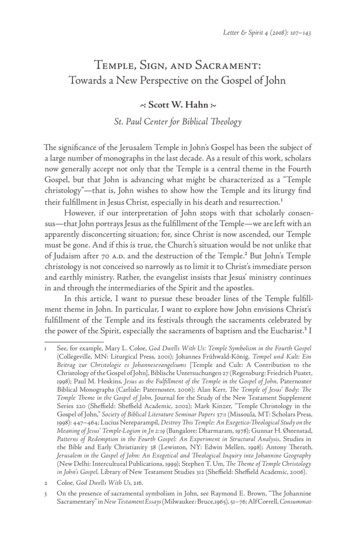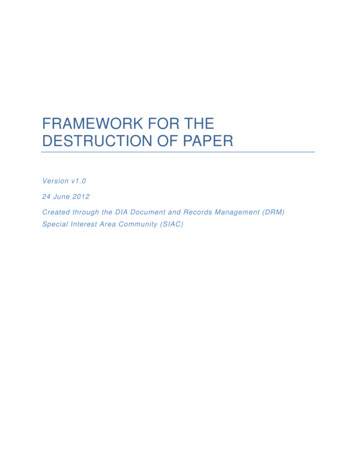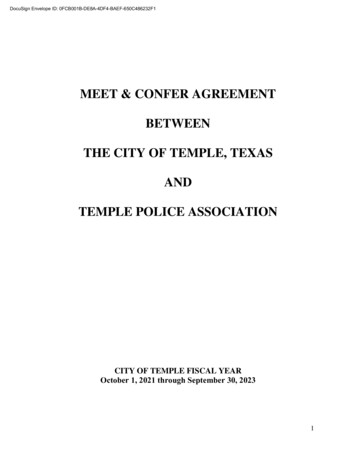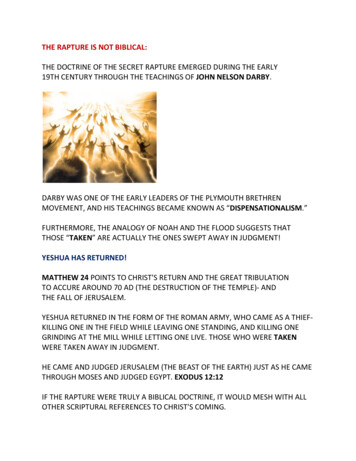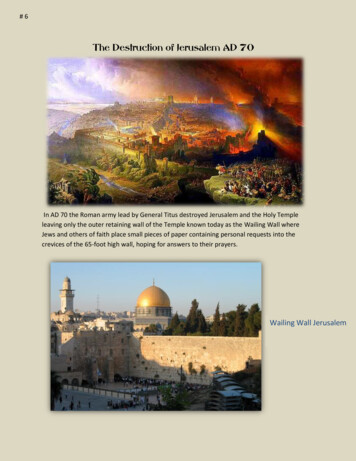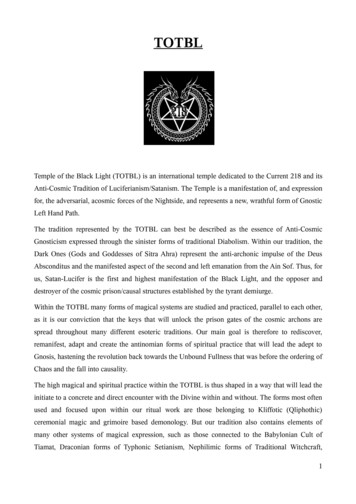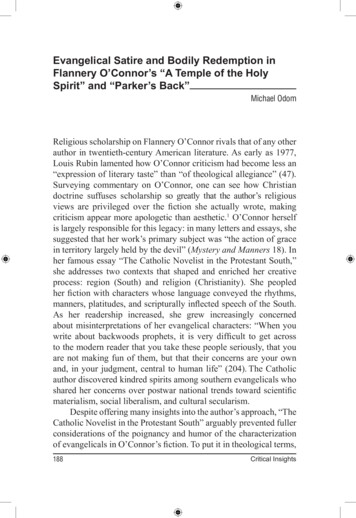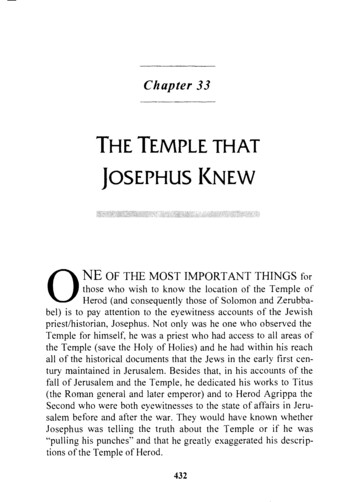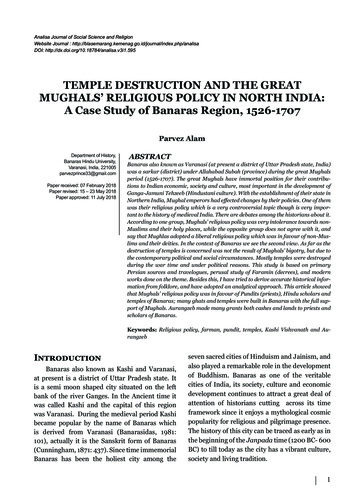
Transcription
Analisa Journal of Social Science and ReligionWebsite Journal : /analisaDOI: http://dx.doi.org/10.18784/analisa.v3i1.595TEMPLE DESTRUCTION AND THE GREATMUGHALS’ RELIGIOUS POLICY IN NORTH INDIA:A Case Study of Banaras Region, 1526-1707Parvez AlamDepartment of History,Banaras Hindu University,Varanasi, India, 221005parvezprince33@gmail.comPaper received: 07 February 2018Paper revised: 15 – 23 May 2018Paper approved: 11 July 2018ABSTRACTBanaras also known as Varanasi (at present a district of Uttar Pradesh state, India)was a sarkar (district) under Allahabad Subah (province) during the great Mughalsperiod (1526-1707). The great Mughals have immortal position for their contributions to Indian economic, society and culture, most important in the development ofGanga-Jamuni Tehzeeb (Hindustani culture). With the establishment of their state inNorthern India, Mughal emperors had effected changes by their policies. One of themwas their religious policy which is a very controversial topic though is very important to the history of medieval India. There are debates among the historians about it.According to one group, Mughals’ religious policy was very intolerance towards nonMuslims and their holy places, while the opposite group does not agree with it, andsay that Mughlas adopted a liberal religious policy which was in favour of non-Muslims and their deities. In the context of Banaras we see the second view. As far as thedestruction of temples is concerned was not the result of Mughals’ bigotry, but due tothe contemporary political and social circumstances. Mostly temples were destroyedduring the war time and under political reasons. This study is based on primaryPersian sources and travelogues, perusal study of Faramin (decrees), and modernworks done on the theme. Besides this, I have tried to derive accurate historical information from folklore, and have adopted an analytical approach. This article showedthat Mughals’ religious policy was in favour of Pundits (priests), Hindu scholars andtemples of Banaras; many ghats and temples were built in Banaras with the full support of Mughals. Aurangzeb made many grants both cashes and lands to priests andscholars of Banaras.Keywords: Religious policy, farman, pundit, temples, Kashi Vishvanath and AurangzebIntroductionBanaras also known as Kashi and Varanasi,at present is a district of Uttar Pradesh state. Itis a semi moon shaped city situated on the leftbank of the river Ganges. In the Ancient time itwas called Kashi and the capital of this regionwas Varanasi. During the medieval period Kashibecame popular by the name of Banaras whichis derived from Varanasi (Banarasidas, 1981:101), actually it is the Sanskrit form of Banaras(Cunningham, 1871: 437). Since time immemorialBanaras has been the holiest city among theseven sacred cities of Hinduism and Jainism, andalso played a remarkable role in the developmentof Buddhism. Banaras as one of the veritablecities of India, its society, culture and economicdevelopment continues to attract a great deal ofattention of historians cutting across its timeframework since it enjoys a mythological cosmicpopularity for religious and pilgrimage presence.The history of this city can be traced as early as inthe beginning of the Janpada time (1200 BC- 600BC) to till today as the city has a vibrant culture,society and living tradition.1
Analisa Journal of Social Science and Religion Volume 03 Number 01 July 2018pages 1-18According to Irfan Habib, “Religion has beenan undoubted component of human civilizationin its various stages of evolution.” (Habib, 2007:142). It played its significant role in acting onbehalf of the ruling classes; however, everydynasty had ruled according to the contemporarytradition. If we observe closely all phenomena,religion has been a means to get political powerthrough alluring the notions of the people evennow. After their victory in Northern India,Mughal emperors had effected changes by theirpolicies. One of them was their religious policywhich is a very controversial topic although it isvery important to the history of medieval India.There are debates among the historians about it.One view is that being a Muslim ruler, the Islamiclaw was dominant in the shaping of religiouspolicy and there was no room for other religions’law. Except Akbar all rulers were intolerants tonon-Muslims, and their holy places. Aurangzebwas more bigot ruler than others; due to hispartial religious policy Hindus, Jats, Satnamis,Marathas and others raised rebellious flag againstthe Mughal empire that eventually caused thedecline of the Mughal empire (Sarkar, 1912-1924;Lane-Poole, 1924; Sharma, 1940; Nehru, 1946;Husain, 2002; Sharma, 2017). On the contrarythe opposite view is that the entire field of thepersonal law of their subjects were covered bythe Hindu and Muslim laws over which they hadno authority to change. The emperors, however,called themselves agents of Islam; even this lefta very wide margin of freedom to the citizens intheory and in practices. The Mughals ruled overIndia according to Indian tradition, and did nottry to impose Islamic law on their subjects whichwere mostly non-Muslims (Faruki, 1935; Ali,1966 and 2006; Chandra, 1969; Truschke, 2017).Banaras was the most sacred place ofHinduism, abode of Brahmans and Vedanticlearning during the medieval period as Frenchtraveller Francois Bernier (1620-1688) whovisited to Banaras in 1665 says, “The town ofBenares, seated on the Ganges, in a beautifulsituation, and in the midst of an extremelyfine and rich country, may be considered the2general school of the Gentiles. It is the Athensof India; whither resort the Brahmens and otherdevotees” (Bernier, 1916: 334). Here studyingthe controversial region Banaras, witnessed ofvicissitude in religious life due to the Mughalreligious policy, the destruction of Vishvanathtemple and the construction of Gyanvapi mosque,is look into how was the religious situation ofBanaras during the Mughal period; Were Hinduand Muslim inhabited peacefully together in thecity; How many ghats, temples and monasterieswere constructed; How slightly changed Mughalreligious policy in Aurangzeb’s reign; What werethe causes of temple destruction of Banaras,and to find out the causes of the demolition ofVishvanath temple? In this paper an attempt ismade to answer these questions. In spite of this,an endeavour is made to show that Mughals werenot intolerant; they run the state with the supportand corporate of the people of India belonging todifferent castes and religions; they maintainedthe state policy similar to everyone without anydiscrimination of caste and creed; they ruledaccording to contemporary situations whicheverwere in the favour of the state. Whatsoever workshave been done on Banaras mentioned belowdoes not reasonably shed light on these aspects.The first scholarly work on Banaras was doneby M. A. Sherring (1826-80) who wrote Benares,the Sacred City of the Hindus in Ancient andModern times in 1868. His study mainly focusedon religious and cultural life of Banaras during thenineteenth century with occasional accounts ofancient history. Sherring’s next book on Banaraswas Hindu Tribes and Castes as Represented inBenares published in three volumes during 18721881. In this book he has tried to describe castesand tribes of Hindu inhabited in the nineteenthcentury of Banaras. E. B. Havell’s Benares,the Sacred City (1905) described religious andlearning aspects of Hindus, Jains and Buddhistsof ancient Banaras. Besides this, Havell alsopresented a vivid picture of temples, ghats, andrites and rituals of nineteenth century Banaras.He has totally overlooked medieval Banaras.Motichandra (1985) wrote Kashi Ka Itihas in 1962
Temple Destruction and The Great Mughals’ Religious Policy In North India: A Case Study Of Banaras Region, 1526-1707Parves Alamwhich delineated political history of medievalBanaras. He presents the military conquest ofBanaras by the Muslims and in this process howthe temples of Banaras were destroyed. However,he is not substantiating his argument with theappropriate contemporary primary sources.He only mentioned temple destruction but notanalysed the reasons. For a historian it is verydifficult to accept his version because of paucityof relevant sources in his writings. KubernathSukul’s Varanasi Vaibhav (1977) and Diana L.Eck’s Banaras: City of Light (1982) proposedthat there were many troubles and conflicts inBanaras during the Mu slim rule were not goodfor Hindu institutions. K. Chandramouli (2006)wrote Luminous Kashi to Vibrant Varanasi in2006. He focussed on Banaras trade in brief,silk, arts and crafts, painting and music. We findsome glimpses of economic condition of Banarasin the writing entitled Subah of Allahabad underthe great Mughals, written by S. N. Sinha in1974. Tarannum Fatma Lari’s book Textiles ofBanaras: Yesterday and Today (2010) soughtthe historical development and technical aspectsof Banarasi saris. Jaya Jaitlya’s book WovenTextiles of Varanasi (2014) shed light on textiles.Madhuri Desai’s work on Banaras Reconstructed:Architecture and Sacred Space in a Hindu HolyCity published in 2017; it presents the history,building and its architectural features of Banarasfrom 1590 to 1930. The iconic Hindu centrein Northern India Banaras was reconstructedmaterially and imaginatively, and embellishedwith temples, monasteries, palaces and ghats.She argued that many temples, monasteries andghats were constructed during the Mughal period.Temple desecration and destruction hasbeen a controversial and hot topic among thehistorians after the destruction of Baburi mosqueof Ayodhya in 1992. Following this shamefulhappening, Richard M. Eaton wrote a monographentitled Temple Desecration and Muslim Statesin Medieval India in 2000. In this book he raisessome questions regarding to temple destruction:In fact what temples were desecrated or destructedduring the period of medieval India? When andby whom? How and for what purpose? In thosedays temples were patronized by the ruler andassociated with the ruler, and deity placed in theroyal temple was considered as a co-sovereign. So,if a ruler defeated another ruler, it was necessarywork for the victorious king that he had todestroy not only the enemy king and his army butalso the deity located in the royal temple. If thevictorious king did not desecrate or destroy theroyal temple of enemy, there would be chances ofuprising because the locals by assembling aroundthe old deity could stand against the conqueringruler. This was a process of sweeping away of allprevious political sovereignty. Eaton says,“When such authority was vested in a ruler whoseown legitimacy was associated with a royal temple-typically one that housed an image of a rulingdynasty’s state-deity, or rashtra-devata (usuallyVishnu or Shiva) - that temple was normally looted, redefined, or destroyed, any of which wouldhave had the effect of detaching a defeated rajafrom the most prominent manifestation of hisformer legitimacy. Temples that were not soidentified or temples formerly so identified butabandoned their royal patrons and thereby rendered politically irrelevant, were normally left unharmed. Such was the case, for example, with thefamous temples at Khajuraho south of the middleGangetic Plain, which appear to have been abandoned by their Chandella royal patrons beforeTurkish armies reached the area in the early thirteenth century” (Eaton, 2004: 31).Such act in fact started in India sevencenturies before the invasion of Turks. Eatonlists the Hindu kings from various dynastiesas the Pallavas, the Chalukyas, the Cholas, thePandyas, and the Rashtrakutas were indulge inthis practice. Hence this established pattern wasfollowed and continued by the Turk invaders,Delhi Sultans and later on by the great Mughals(Eaton, 2004: 35-46).The act of temple demolition also occurredin Indo-Muslim state if any Hindu officer showedsign of uprising and disloyalty, the state withoutany delay attacked on the territory of that officerdefeated him and destroyed the royal templeassociated with him. Contrary to temples lyingwithin the kingdom were considered as stateproperty and it was the duty of state to protect3
Analisa Journal of Social Science and Religion Volume 03 Number 01 July 2018pages 1-18these temples, they did so. This practice was invogue in India before the coming of Mughalswho followed the same pattern. When Jahangirmarched against his arch enemy Rana AmarSingh of Mewar in 1613, he ordered for thedesecration of Varah statue that had been housedin a temple at Pushkar (Ajmer) associated withRana Amar. Similarly Shah Jahan demolishedthe grand temple at Orchha in 1635 when the rajarevolt against the emperor (Eaton, 2004: 59, 60).Not only temples were desecrated anddemolished but mosques were also face thesame fate by Hindus. When rulers or rebellionssucceeded in subduing their Muslim counterpart,we see the Hindu parallel of Muslim iconoclasm.Sufi literature of Lahore mentioned that whenMahi Pal sacked Lahore, many Muslims werekilled and mosques were demolished, andHindu temples were built in its place (Ahmad,2002: 89). According to Abbas Khan Sarwani,the Hindu landlords in Malwa and the regionsaround Delhi destroyed mosques and set uptemples by the debris of mosques in the fifteenthcentury (Elliot and Dowson, 1872: 403-404). It issaid about Rana Kumbha that he captured manyMuslim women and had destroyed a mosque(Ahmad, 2002: 89). Rai Sen, a confederate ofRana Sanga, converted mosques into stables andplastered with cow-dung at Chanderi, Sarangpurand Ranthambore. Shaikh Ahmad Sarhindilamented on the desecration of mosques in theearly seventeenth century (Ahmad, 2002: 89).The same practice was practised by the Sikhsand the Jats in the eighteenth century. JadunathSarkar says,“Under Badan Singh the Jats roamed freely overthe (Agra) province demolishing houses, gardensand mosques, disfiguring them for the sake of aknob of copper, a piece of marble or a bit of iron”(Sarkar, 1938: 315).Research methodThis study is largely based on the literarytexts, and other interrelated documents availablein the Persian, Arabic and other local languages. Ihave consulted the primary Persian sources, travel4accounts and the local sources, and used archivewhere faramin issued by Mughal emperors arekept, in the preparation of this article. Giving thelimitation of language, I have tried to make use ofvarious materials translated from original sourcesto develop my argument. This study is analytical,comparative and corroborative in nature aimingto interrogate different sources with a view toestablish the veracity of the facts by scrutinizingdifferent sets of documents. I have also conductedfield study in the course of this to verify theexisting structures, monuments, archives andlibraries to substantiate my argument withreliable evidences.Result and discussionBanaras before the Coming of theMughalsHere it would be pertinent to know theentry of Muslims in Banaras. It is said thatMahmud Ghaznavi invaded Banaras twice in1019 and 1022 (Nevill, 1909: 189). But we findthe authentic history of Muslims’ entry from thetime of Muhammad Ghori who came along withhis commander Qutub-ud Din Aibak (1206-1210)who later on laid the foundation of Delhi Sultanate(1206-1526) in 1206. They conquered Banaraswhich was denominated as a second capital bythe Gahadavala rulers who usually gave grantsto Brahmins of Banaras, and projected for theconstruction of temples, after defeating Gahadvalaking Jai Chand in the battle of Chandawar in1194. In the conquering process, there about onethousand temples were destroyed in Banarasregion (Elliot and Dowson, 1869: 223). Certainlythe number of destroyed temples is exaggeratedbecause when Chinese traveller Hiouen Thsangor Xuanzang (602-664) visited Banaras inseventh century, he mentioned that there werefrom twenty to more than a hundred templeswithin the city or the whole region (Desai, 2017:17, 18). Therefore, when Banaras was kept undera governor after 1194, the settlement of Musliminitiated in this region, while some non-Muslimsconverted to Islam. After this victory Banaras
Temple Destruction and The Great Mughals’ Religious Policy In North India: A Case Study Of Banaras Region, 1526-1707Parves Alamremained under the control of Delhi Sultanate andlater on the Mughals. During the Delhi Sultanateon the one hand many temples of Banaras weredestroyed during the war time, on the other handwe have references that show some temples werebuilt also in Banaras by Delhi sultans such as therebuilding of the Vishvanath temple in Iltutmish’sreign (1211-36) (Motichandra, 1985: 150) andPadmesvara temple during the reign of AlauddinKhilji (1296-1316) (Fuhrer, 1971: 51).During this time the Bhakti movement wasmost popular in Banaras. The champions of itlike Ramanand (1299-1411), Kabir (1398-1518),Vallabhacharya (1477-1530), Tulsidas (15321623) and their disciples who either visitedor lived in Banaras influenced the society andculture through their works. They always triedto promote fraternity among the people withoutany discrimination of caste and creed. But, byand large, Hinduism was most popular religionin Banaras, and Pundits (priests) had dominantinfluence over the Hindus. Ralf Fitch, an Englishtraveller who visited India between 1583- 1591,mentioned that Banaras city was full of thepopulation of “Gentiles” who were the greatestidolaters. “Gentiles” come to this town onpilgrimage from far countries (Ryley, 1899: 103).Banaras and Mughal Religious PolicyThis was the situation in Banaras on the eveof Babur’s entry into India. After the victoriousbattle of Panipat (at present it is in Haryanadistrict) in 1526, Babur started to conquer andto consolidate his newly established empire. Inthis process, he had to fight against the Rajputsof Rajasthan. Before the battle of Khanwa(presently in Bharatpur, Rajasthan) in 1527, heused the term jihad1 for his soldiers who werenot willing to fight with Rajputs because of tworeasons; one, they were homesick and anotherthey had heard of the bravery of the Rajputs.However, in the battle of Panipat, he did not usethe term jihad. So it seems that his proclamationof jihad was only to encourage his soldiers. S. R.Sharma pointed out that in Babur’s time sometemples were destroyed. His one officer namedHindu Beg converted a temple into mosqueat Sambhal (Uttar Pradesh). During the timeof occupation Chanderi his sadr Shaikh Zaindemolished many temples there. Similarly MirBaqi destroyed the Ayodhya or Saketa (Faizabad,Uttar Pradesh) temple, the birth place of LordRama, and constructed a grand mosque in itsplace in 1528-29 by the order of Babur. Baburwas also responsible for the destruction of Jainidols at Urva near Gwalior (Sharma, 1940: 9).However, Sharma’s argument related to templedestructions were not supported by the pertinentprimary sources. If these examples are truethen also it is obvious that all the act of templedestruction occurred only during the war timesnot in times of peace.Since Babur was entangled in wars, he did notdetermine any specific religious policy of his own.After the victory of Awadh in 1529, he appointedJalal-ud Din Khan Sharqi as the governor ofBanaras (Babur, 2014: 652). Suddenly, in a chaoticsituation, Babur died. So, his successor Humayunhad to face many problems. After conquering thefort of Chunar, Humayun laid siege to Banarasin 1531; it appears that during this time, he wentto see the Chaukhandi stupa of Sarnath. Toremember this event Govardhan, son of TodarMal, built an octagonal edifice (AthapahalaMahal) at Sarnath in 1589 (Motichandra, 1985:160). Showing a tolerant policy, Humayun madea grant of 300 acres of land to the JangambadiMath (a monastery of the Jangam sect of theShaiva of South India) of Banaras through afarman. The land grant was situated in Mirzapurdistrict. This original farman of Humayun is stillpreserved in the Jangambadi Math of Banaras.It is obvious that Humayun could not avail ofopportunities to get the support of Rajputs. Dueto ups and downs of situation, he had to leaveIndia in 1540 for some years. When he cameback and succeeded to capture Delhi in 1555,he suddenly died in 1556. So, like his father, healso could not get time to determine any specificreligious policy. But both knew very well how to5
Analisa Journal of Social Science and Religion Volume 03 Number 01 July 2018pages 1-18handle the situation in a multi-religious country.Learning from the past and the experience ofhis predecessors and the demand of the presentsituation, Akbar the great (1556-1605) introduceda prolific type of tolerant religious policy of hisown which helped to establish the Mughal state inIndia firmly. His religious policy was intimatelyconnected with his own religious views. Herealized that truth was an inhabitant of everyplace. He abolished the pilgrimage tax (It hasbeen the custom of every Muslim ruler of India torealise pilgrimage tax from the every pilgrimageplace of non-Muslims) in 1563; behind it his viewwas as Mountstuart Elphinstone says,“Although the tax fell on a vain superstition, yet,as all modes of worship are designed for one greatBeing, it was wrong to cut the devout off fromtheir mode of intercourse with their Maker” (Elphinstone, 1841: 326).In 1564 jizyah (religious tax levied on nonMuslim) was also abolished by Akbar. Theseacts of Akbar were very revolutionary in thosedays. It indicates how Akbar was conscious ofreligious equality among his subjects. Because ofhis liberal religious policy, a notion of nationalunification and fraternity between Muslims andnon-Muslims developed. Till 1567, Akbar couldnot give proper attention to Banaras because ofhis early difficulties. In the same year it is heardthat a dilapidated temple was converted into amadrasah (college) by the shiqdar (governor)of Banaras named Bayazid Bayat. When Akbarcame to know about this happening, he dismissedBayazid, and gave two villages for the allowancesof the teachers of this temple (Bayazid Bayat,1941: 263, 264). Thereafter, Akbar properly gaveattention to Banaras. Like his father, he also madea grant of 100 bighas of land to the JangambadiMath of Banaras and confirmed an earlier grantmade by Humayun (Ansari, 1973: 251, DocumentI and III).In fact, Akbar not only permitted therebuilding of temples, but also sponsored them.Some of the Hindu Rajputs of Rajasthan, whowere the allies of the emperor, participatedactively in the construction of Banaras ghats and6temples during Akbar’s time. The reconstructionof Vishvanath or Vishveshwar temple wasa significant event; Todar Mal rendered inavailable support through Narain Bhatta to thereconstruction of Vishwanath temple in 1585.He was also responsible in the construction ofDraupadikund at Shivapur in 1589 (Motichandra,1985: 162). Man Singh built many ghats (ford)and temples. Manmandir ghat is one of the mostfamous ghats, which was constructed by him inca. 1600 (Sherring, 1975: 42, 43). Ralf Fitch hasmentioned that many buildings were built on thebank of the river Ganges; different types of idolsmade of different kind of materials housed inthose buildings which charges were in the handsof Brahmin priest who performed religious rituals(Ryley, 1899: 103-108).In 1582, Akbar realized the unification ofall religions, and introduced a new order that iscalled in history as Tauhid-i Ilahi (the assertionof the unity of God).2 We see the influence ofthis order at Banaras also. A Muslim of Banarasnamed Gosala Khan who accepted Tauhid-iIlahi. By the courtesy of Abul Fazl (1551-1602),a court historian of Akbar, Gosala Khan got achance to enter into imperial army (Badauni,1990 : 418, 419). The birth of Tulsidas in Banaraswas a significant event in the history of Banarasduring the reign of Akbar and Jahangir. It wasthe Mughals whose empire ‘the freedom ofspeech’ and ‘the freedom of writing’ existed. Thebest example is Tulsidas who not only composedRamchartimanas and Vinaya Patrika but alsoto some extent criticised the Mughal emperors,and put the concept of Ram Rajya (the realmof Lord Rama). We find a vivid picture of thecontemporary rites, rituals, beliefs and temples ofBanaras through Vinaya Patrika (Tulsidas, 1956:31-34). On the basis of the above, we can say thatBanaras had reached at the peak of syncretism inthe early 17th century.At the death of Akbar, the Mughal Empire hadspread over almost the whole north India, andsome parts of south India. Due to Akbar’s policies,the Indians started to conceive the Mughals asIndians, not foreigners. So it was necessary for
Temple Destruction and The Great Mughals’ Religious Policy In North India: A Case Study Of Banaras Region, 1526-1707Parves Alamthe next Mughal emperor Jahangir (1605-27)to maintain this notion. Indeed, Jahangir didaccording to the contemporary condition. Hecontinued Akbar’s tolerant religious policy. Therewas no any discrimination between Muslims andnon-Muslims in his empire. After his accession,he issued twelve edicts; one of them was anadmonition to high nobles especially in borderareas against forcing Islam on any of the subjectsof the empire (Mukhia, 2004: 30). Like his fatherhe gave permission to Hindus for the donation,and construction of temples. Jahangir’s closefriend and vassal Vir Singh Deo Bundela, the rulerof Orchha (1605-1626), donated a gold casing forthe pinnacle of the Vishvanath temple of Banaras(Desai, 2017: 43). He also built temples at Muttraor Mathura (birth place of Lord Krishna, UttarPradesh), and Bundelkhand (Madhya Pradesh).Reciprocally whenever Jahangir fought againstHindu kings, naturally temples were desecratedand destroyed (Ahmad, 2002: 88).Jahangir experimented in the simultaneousmaintenance of several religions by the state.The construction of more than seventy templeswas started in Banaras alone towards the end ofhis reign; however, all these temples could notbe completed when Jahangir died in 1627 (Elliotand Dowson, 1877: 36). At this time, a CentralAsian traveller, Mahmud bin Amir Ali Balkhivisited Banaras and was horrified to see a groupof twenty three Muslims (former Hindus) whohad deserted their religion and turned Hindu,after having fallen in love with Hindu women. Forsome time, he held their company and questionedthem about their mistaken ways. They pointedtowards the sky and put their fingers on theirforeheads. By this gesture, he understood thatthey attributed it to Providence (Mukhia, 2004:39). So, this fascinating story indicates thateverybody was free to follow his religion withoutany fear in Banaras during Jahangir’s reign. TheEnglish traveller Edward Terry (1590-1660) alsodescribed the freedom of religion in Jahangir’sreign. According to him, every man had liberty toprofess his own religion freely (Foster, 1921: 315).The Italian traveller Pietro Della Valle (1586-1652)also mentioned that the people of Hindustanlive mix together and peacefully in the reign ofJahangir who provided equal opportunities tothem in civil and military services (Pietro DellaValle, 1891: 30).From the beginning of Shah Jahan’s reign(1627-58), the orthodox ulama (scholars) hadtried to get high position in shaping of the statepolicies, but had not succeeded except for a few.The textbooks often present the picture of ShahJahan as an orthodox Muslim king, and indeedhe did take some pride in calling himself a kingof Islam. But he continued the tolerant policy ofhis grandfather Akbar and father Jahangir. In thethirty years of his reign, he continued to appointand promote Rajputs to high ranks. It is clearthat Shah Jahan followed the traditional policyin employing Rajputs in state services (Ali, 2006:201, 202). But as far as the matter of the Hindutemples is concerned, his policy was somethingdifferent from his grandfather and father. Heordered not to demolish old temples but didnot allow the construction of new temples. Heembarked on a campaign of complete destructionof the newly constructed Hindu temples. As aresult, seventy six temples were destroyed inBanaras (Elliot and Dowson, 1877: 36). Thisincident is also mentioned by Peter Mundy (160867) who had travelled to India during this period(Mundy, 1914: 178).Shah Jahan did not impose jizyah, but he triedto re-impose the pilgrimage tax on non-Muslims.But owing to the persuasion of a Hindu scholar ofBanaras named Kavindracharya Sarasvati (162770) who wrote a commentary on the Rigvedaled a deputation to the emperor to request notto re-impose the pilgrimage tax. Accepting hisrequest, Shah Jahan revoked pilgrimage tax onBanaras and Allahabad, and gave his non-Muslimsubjects religious liberty (Hasrat, 1953: 112, 115;Motichandra, 1985: 174; Truschke, 2016: 37,191). This shows that how much Shah Jahan wasunder the influence of Kavindracharya. AudreyTruschke who investigated the literary, socialand political roles of Sanskrit at the Mughalcourts in her famous book Culture of Encounters7
Analisa Journal of Social Science and Religion Volume 03 Number 01 July 2018pages 1-18(2016), argues that Kavindracharya, Brahmendraand Purnendra Sarasvati belonging to Brahmincommunity were famous Sanskrit scholars andleaders of Banaras of Shah Jahan period; theymuch influenced contemporary literature, socialand politics. When Kavindracharya succeededin the abolishing of pilgrimage tax convincingto Shah Jahan, in the praise of him, there wereabout seventy scholars composed a book entitledKavindrachandrodaya (Moonrise of Kavindra).Shah Jahan and his son Dara Shikoh learnedfrom him philosophy, poetry and Yogavasisthain Sanskrit language (Truschke, 2016: 50, 191).Most probably because of Kavindracharya thelove for Sanskrit literature arose in Dara Shikos’heart, Shah Jahan also made grants to the punditsof Banaras. During his visit to Banaras in 1665Francois Bernier writes,“I passed through Benares, and called upon thechief of the Pendets, who resides in that celebrated seat of learning. He is a Fakire or Devotee soeminent for knowledge that Chah Jeha
royal temple was considered as a co-sovereign. So, if a ruler defeated another ruler, it was necessary work for the victorious king that he had to destroy not only the enemy king and his army but also the deity located in the royal temple. If the victorious king did not desecrate or destroy the royal temple of enemy, there would be chances of


